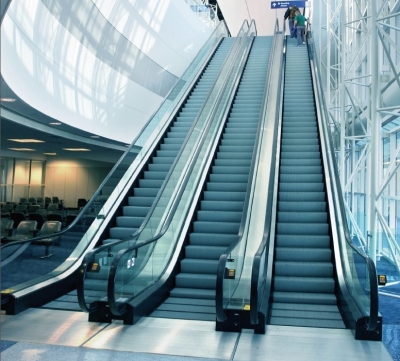
Many wrong answers with many upvotes. A couple of actual escalator mechanics pointed that out, but unfortunately, other than saying that by design the handrail should move at the same speed, did not answer the question.
An average armchair scientist will try to explain it by pointing out that the handrail belt is longer than the string of stairs. But that is not the reason.
First: How can the handrail on an escalator go at the same speed as the stairs?
The handrail and the steps do not need to be driven in a way that makes them do a full round at the same time. Nobody cares if the hidden portion of the handrail belt is longer, and the next time a certain stair emerges, a completely different portion of the handrail belt travels alongside it. All that matters is that, at least during the straight portion, they travel at the same linear velocity.
An escalator is driven by a single motor. The stairs and the handrail belt are driven by separate wheels, coupled by a chain drive
To match the speeds, two things are relevant: gear ratio of the chain drive, and the outer diameter of the wheel that drives the handrail belt. Nothing fancy.
Can the handrail go at exactly the same speed as the stairs?
If the handrail was driven by teeth, like a toothed belt, then yes, it could run at exactly the same speed. However, it is driven by friction.
Over time, the rubber on the drive wheel wears out, thus reducing its diameter. So, over time, the handrail is going to run somewhat slower. If the rubber wears down to the metal (or if the rubber hardens), it will start slipping and the handrail will move in a jerky fashion and will be lagging considerably.
Why would the handrail go faster than the stairs?
Let’s assume that when the rubber on the drive wheel wears down by 3 mm (1/8?), the handrail lags 80 mm (3?) over the course of 8 m (26 ft). That’s about 1%.
Some standards require that the speed should not deviate more than 2%. Some standards specify a load (a force) which should not slow down the handrail. Now, considering that the drive wheel will wear down, and that some slippage may occur due to dust and grease, the specification for a brand new drive wheel is probably adjusted ‘to be on the safe side’, causing the handrail to run 1–2% faster than the stairs. By targeting the new drive wheel at +2%, one could get double the service life out of it.
It is possible that the newer materials aren’t wearing down as fast as the ones used before. A well maintained escalator might therefore always have a handrail running fast.
Does the handrail always go faster than the stairs?
In different countries there are different standards. And different manufacturers — some more concerned with service life, others possibly focused more on passenger comfort. Then there are different designs, some maintain the handrail speed better than others. So, no, not all people will agree that the handrail always goes faster than the stairs.
Alternate explanation
Some people suggest that handrails run faster than the stairs for escalators going up, and slower than the stairs for escalators going down. The idea is that in case a rider is not paying attention, and is relying on the handrail for balance, they should fall on the stairs upwards, rather than downwards.
It is possible that this was intentionally done in some installations. It is also possible that one notices such a difference in installations where the drive wheels on escalators going up had worn down and were replaced, while the ones on escalators going down are still the original ones, since they don’t wear down as much.
Credit : Quora
Picture Credit : Google




